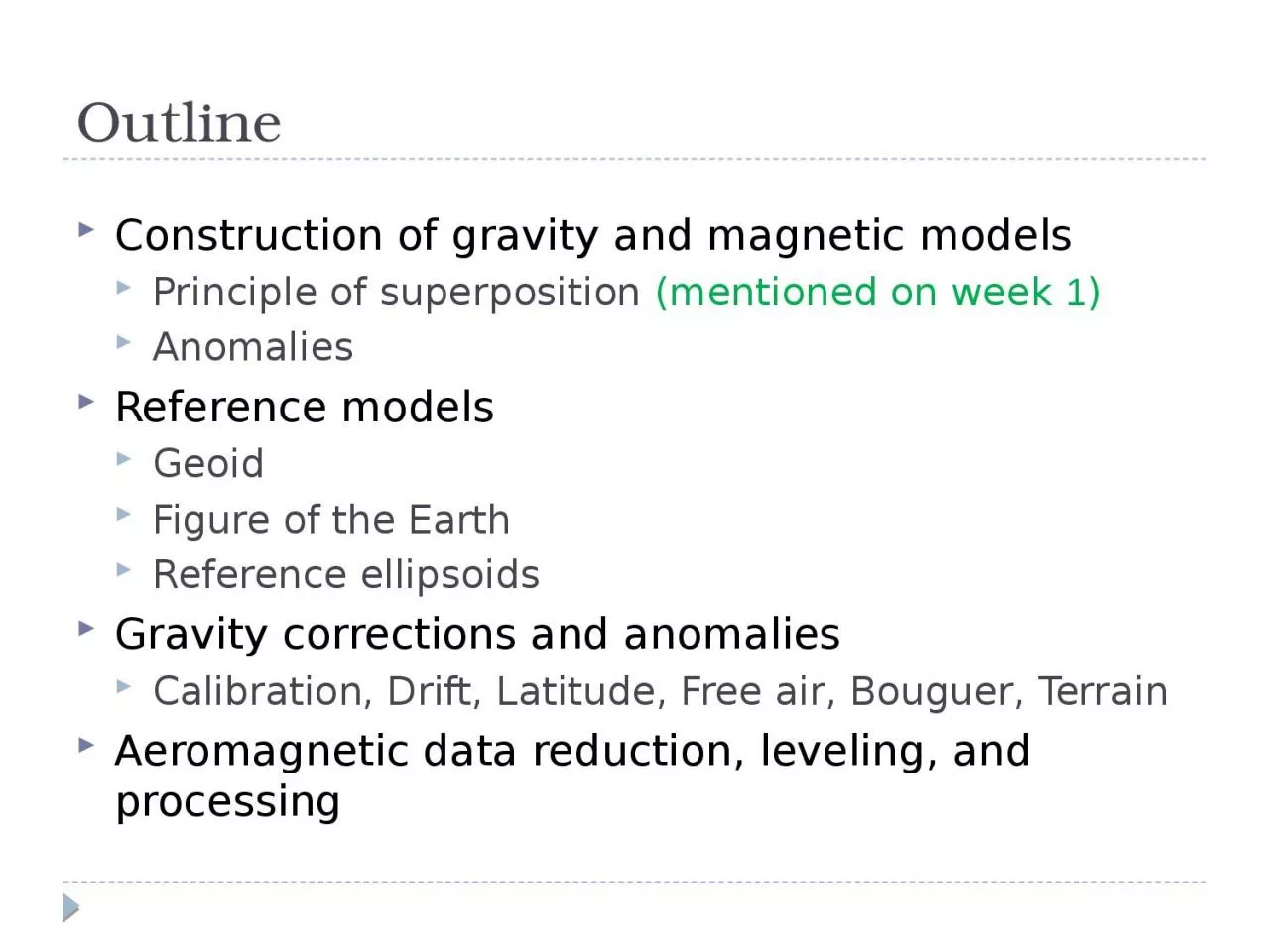

Principle of superposition mentioned on week 1 Anomalies Reference models Geoid Figure of the Earth R eference ellipsoids G ravity corrections and anomalies Calibration Drift Latitude Free air ID: 1024502
Download Presentation The PPT/PDF document "Outline Construction of gravity and magn..." is the property of its rightful owner. Permission is granted to download and print the materials on this web site for personal, non-commercial use only, and to display it on your personal computer provided you do not modify the materials and that you retain all copyright notices contained in the materials. By downloading content from our website, you accept the terms of this agreement.
1. OutlineConstruction of gravity and magnetic models Principle of superposition (mentioned on week 1)AnomaliesReference modelsGeoidFigure of the EarthReference ellipsoidsGravity corrections and anomaliesCalibration, Drift, Latitude, Free air, Bouguer, TerrainAeromagnetic data reduction, leveling, and processing
2. Gravity anomaliesThe isolation of anomalies (related to unknown local structure) is achieved through a series of corrections to the observed gravity for the predictable regional effectsAccording to Blakely (page 137), it is best to view the corrections as superposition of contributions of various factors to the observed gravity (next slide)
3. Gravity anomaliesObserved gravity = attraction of the reference ellipsoid (figure of the Earth)+ effect of the atmosphere (for some ellipsoids)+ effect of the elevation above sea level (free air)+ effect if the “average” mass above sea level (Bouguer and terrain)+ time-dependent variations (drift and tidal)+ effect of moving platform (Eötvös)+ effect of masses that would support topographic loads (isostatic)+ effect of crust and upper mantle density (“geology”)If we model and subtract these terms from the data……then the remainder is the “anomaly” (for example, “free air” or “Bouguer” gravity)
4. Geoid and Reference EllipsoidGeoid is the actual equipotential surface at (regional) mean sea levelReference ellipsoid is the equipotential surface in a uniform EarthMuch more precisely known from GPS and satellite gravity dataRecent recommendations are to reference all corrections to the reference ellipsoids and not to the geoid
5. Hydrostatic rotating EarthThe surface of static fluid is at constant potential :Therefore:Gravity potentialCentrifugal potentialConventionally, the equatorial radius is used for referencing:where:
6. Gravity flatteningBecause of rotation, gravity decreases with colatitude q:Parameter b is called “gravity flattening”:so that the gravity at the pole equalswhere
7. Reference EllipsoidsInternational Gravity FormulaEstablished in 1930; IGF30Updated: IGF67World Geodetic System (last revision 1984; WGS84)Established by U.S. Dept of DefenseUsed by GPSSo the gravity field is measured above the atmosphereThe difference from IGF30 can be ~100 mA number of other older ellipsoids used in cartographyAlso note the International Geomagnetic Reference Field: IGRF-11
8. Gravity flattening and the shape of the EarthExercise: from the expressions for the Earth’s figure and gravity flattening, show that the radius at colatitude q can be estimated from measured gravity as:
9. Multi-year drift of our gravity meterDuring field schools, the G267 gravimeter usually drifts by 0.1-0.2 mGal/day
10. Bullard B correctionNecessary at high elevations (airborne gravity)Added to Bouguer slab gravity (subtracted from Bouguer-corrected gravity) to account for the sphericity of the Earth Elevation above reference ellipsoid, h (m)Bullard B correction (mGal)
11. Instrument Drift correctionDuring the measurement, the instrument is used at sites with different gravity gs and also experiences a time-dependent drift d(tobs)Therefore, the value measured at time tobs at station s is:For d(t), we would usually use some simple dependence; for example, a polynomial function:where d0 is selected to ensure zero mean: <d(t)> = 0, that is:(*)
12. Instrument Drift correction (cont.)Equation (*) is a system of linear equations with respect to all gs and ak:where m is a vector of all unknowns:
13. Instrument Drift correction (cont.)… u is a vector of all observed values:
14. Instrument Drift correction (cont.)… and matrix L looks like this: First columns correspond to gravity stationsLast columns correspond to n drift correction termsRows correspond to recording times
15. Instrument Drift correction (finish)Then, the Least Squares solution of this matrix equation is achieved simply by: Vector m contains all drift terms and all drift-corrected gravity values at all stations considered In Matlab, this can be written as: